Diamond Like Carbon Films Containing Si: Structure and Nonlinear Optical Properties
Abstract
1. Introduction
2. Materials and Methods
3. Results
3.1. Chemical Composition
3.2. Structure
3.3. Optical Properties
4. Conclusions
Author Contributions
Funding
Acknowledgments
Conflicts of Interest
References
- Robertson, J. Diamond-like amorphous carbon. Mater. Sci. Eng. R 2002, 37, 129–281. [Google Scholar] [CrossRef]
- Casiraghi, C.; Robertson, J.; Ferrari, A.C. Diamond-like carbon for data and beer storage. Mater. Today 2007, 10, 44–53. [Google Scholar] [CrossRef]
- Robertson, J. Comparison of diamond-like carbon to diamond for applications. Phys. Stat. Solidi Appl. Mater. 2008, 205, 2233–2244. [Google Scholar] [CrossRef]
- Tyagi, A.; Walia, R.S.; Murtaza, Q.; Pandey, S.M.; Tyagi, P.K.; Bajaj, B. A critical review of diamond like carbon coating for wear resistance applications. Int. J. Refract. Met. Hard Mater. 2019, 78, 107–122. [Google Scholar] [CrossRef]
- Tamulevičius, S.; Meškinis, Š.; Tamulevičius, T.; Rubahn, H.-G. Diamond like carbon nanocomposites with embedded metallic nanoparticles. Rep. Prog. Phys. 2018, 81, 024501. [Google Scholar] [CrossRef] [PubMed]
- Al Mahmud, K.A.H.; Kalam, M.A.; Masjuki, H.H.; Mobarak, H.M.; Zulkifli, N.W.M. An updated overview of diamond-like carbon coating in tribology. Crit. Rev. Solid State Mater. Sci. 2015, 40, 90–118. [Google Scholar] [CrossRef]
- Roy, R.K.; Lee, K.-R. Biomedical applications of diamond-like carbon coatings: A review. J. Biomed. Mater. Res. Part B Appl. Biomater. 2007, 83, 72–84. [Google Scholar] [CrossRef] [PubMed]
- Meškinis, Š.; Tamulevičienė, A. Structure, Properties and Applications of Diamond Like Nanocomposite (SiOx Containing DLC) Films: A Review. Mater. Sci.-Medzg. 2011, 17, 358–370. [Google Scholar] [CrossRef]
- Wu, W.-J.; Hon, M.-H. Thermal stability of diamond-like carbon films with added silicon. Surf. Coat. Technol. 1999, 111, 134–140. [Google Scholar] [CrossRef]
- Kato, N.; Mori, H.; Takahashi, N. Spectroscopic ellipsometry of silicon-containing diamond-like carbon (DLC-Si) films. Phys. Stat. Solidi Appl. Mater. 2008, 5, 1117–1120. [Google Scholar] [CrossRef]
- Jedrzejczak, A.; Batory, D.; Dominik, M.; Smietana, M.; Cichomski, M.; Szymanski, W.; Bystrzycka, E.; Prowizor, M.; Kozlowski, W.; Dudek, M. Carbon coatings with high concentrations of silicon deposited by RF PECVD method at relatively high self-bias. Surf. Coat. Technol. 2017, 329, 212–217. [Google Scholar] [CrossRef]
- Bociaga, D.; Sobczyk-Guzenda, A.; Szymanski, W.; Jedrzejczak, A.; Jastrzebska, A.; Olejnik, A.; Swiatek, L.; Jastrzebski, K. Diamond like carbon coatings doped by Si fabricated by a multi-target DC-RF magnetron sputtering method—Mechanical properties, chemical analysis and biological evaluation. Vacuum 2017, 143, 395–406. [Google Scholar] [CrossRef]
- Nishikawa, J.; Sugihara, N.; Nakano, M.; Hieda, J.; Ohtake, N.; Akasaka, H. Effect of Si incorporation on corrosion resistance of hydrogenated amorphous carbon film. Diam. Relat. Mater. 2018, 90, 207–213. [Google Scholar] [CrossRef]
- Nakazawa, H.; Miura, S.; Nakamura, K.; Nara, Y. Impacts of substrate bias and dilution gas on the properties of Si-incorporated diamond-like carbon films by plasma deposition using organosilane as a Si source. Thin Solid Films 2018, 654, 38–48. [Google Scholar] [CrossRef]
- Zhang, T.F.; Wan, X.; Ding, J.C.; Zhang, S.; Wang, Q.M.; Kim, K.H. Microstructure and high-temperature tribological properties of Si-doped hydrogenated diamond-like carbon films. Appl. Surf. Sci. 2018, 435, 963–973. [Google Scholar] [CrossRef]
- Chaus, A.S.; Jiang, X.H.; Pokorný, P.; Piliptsou, D.G.; Rogachev, A.V. Improving the mechanical property of amorphous carbon films by silicon doping. Diam. Relat. Mater. 2018, 82, 137–142. [Google Scholar] [CrossRef]
- Komori, K.; Umehara, N. Friction and wear properties of tetrahedral Si-containing hydrogenated diamond-like carbon coating under lubricated condition with engine-oil containing ZnDTP and MoDTC. Tribol. Online 2017, 12, 123–134. [Google Scholar] [CrossRef]
- Hatada, R.; Baba, K.; Flege, S.; Ensinger, W. Long-term thermal stability of Si-containing diamond-like carbon films prepared by plasma source ion implantation. Surf. Coat. Technol. 2016, 305, 93–98. [Google Scholar] [CrossRef]
- Evaristo, M.; Azevedo, R.; Palacio, C.; Cavaleiro, A. Influence of the silicon and oxygen content on the properties of non-hydrogenated amorphous carbon coatings. Diam. Relat. Mater. 2016, 70, 201–210. [Google Scholar] [CrossRef]
- Ray, S.C.; Pong, W.F.; Papakonstantinou, P. Iron, nitrogen and silicon doped diamond like carbon (DLC) thin films: A comparative study. Thin Solid Films 2016, 610, 42–47. [Google Scholar] [CrossRef]
- Ahmed, M.H.; Byrne, J.A.; Ahmed, W. Characteristic of silicon doped diamond like carbon thin films on surface properties and human serum albumin adsorption. Diam. Relat. Mater. 2015, 55, 108–116. [Google Scholar] [CrossRef]
- Wu, Y.; Zhang, S.; Yu, S.; Zhu, L.; Shen, Y.; Zhou, B.; Tang, B.; Liu, Y. A self-lubricated Si incorporated hydrogenated amorphous carbon (a-C:H) film in simulated acid rain. Diam. Relat. Mater. 2019, 94, 43–51. [Google Scholar] [CrossRef]
- Batory, D.; Jedrzejczak, A.; Kaczorowski, W.; Szymanski, W.; Kolodziejczyk, L.; Clapa, M.; Niedzielski, P. Influence of the process parameters on the characteristics of silicon-incorporated a-C:H:SiOx coatings. Surf. Coat. Technol. 2015, 271, 112–118. [Google Scholar] [CrossRef]
- Meškinis, Š.; Vasiliauskas, A.; Andrulevičius, M.; Jurkevičiūtė, A.; Peckus, D.; Kopustinskas, V.; Viskontas, K.; Tamulevičius, S. Self-saturable absorption and reverse-saturable absorption effects in diamond-like carbon films with embedded copper nanoparticles. Coatings 2019, 9, 100. [Google Scholar] [CrossRef]
- Cheng, C.-H.; Lin, Y.; Chen, T.; Chen, H.; Chi, Y.; Lee, C.; Wu, C.; Lin, G. Can silicon carbide serve as a saturable absorber for passive mode-locked fiber lasers? Sci. Rep. 2016, 5, 16463. [Google Scholar] [CrossRef]
- Hader, J.; Yang, H.-J.; Scheller, M.; Moloney, J.V.; Koch, S.W. Microscopic analysis of saturable absorbers: Semiconductor saturable absorber mirrors versus graphene. J. Appl. Phys. 2016, 119, 053102. [Google Scholar] [CrossRef]
- Viskontas, K.; Rusteika, N. All-fiber wavelength-tunable picosecond nonlinear reflectivity measurement setup for characterization of semiconductor saturable absorber mirrors. Opt. Fiber Technol. 2016, 31, 74–82. [Google Scholar] [CrossRef]
- Lee, Y.-S.; Lee, S.H.; Kwon, J.-D.; Ahn, J.-H.; Park, J.-S. Silicon oxide film deposited at room temperatures using high-working-pressure plasma-enhanced chemical vapor deposition: Effect of O2 flow rate. Ceram. Int. 2017, 43, 10628–10631. [Google Scholar] [CrossRef]
- Soethoudt, J.; Steven Crahaij, S.; Conard, T.; Delabie, A. Impact of SiO2 surface composition on trimethylsilane passivation for area-selective deposition. J. Mater. Chem. C 2019, 38, 11911–11918. [Google Scholar] [CrossRef]
- Naumkin, A.V.; Kraut-Vass, A.; Gaarenstroom, S.W.; Powell, C.J. NIST X-ray Photoelectron Spectroscopy Database. Available online: http://srdata.nist.gov/xps/ (accessed on 14 December 2019).
- Meškinis, Š.; Tamulevičius, S.; Kopustinskas, V.; Andrulevičius, M.; Guobienė, A.; Gudaitis, R.; Liutvinienė, I. Hydrophobic properties of the ion beam deposited DLC films containing SiOx. Thin Solid Films 2007, 515, 7615–7618. [Google Scholar] [CrossRef]
- Ferrari, A.C.; Robertson, J. Raman spectroscopy of amorphous, nanostructured, diamond–like carbon, and nanodiamond. Philos. Trans. R. Soc. A 2004, 362, 2477–2512. [Google Scholar] [CrossRef] [PubMed]
- Nakazawa, H.; Asai, Y.; Kinoshita, T.; Suemitsu, M.; Abe, T.; Yasui, K.; Itoh, T.; Endoh, T.; Narita, Y.; Konno, A.; et al. Thin-film deposition of silicon-incorporated diamond-like carbon by Plasma-enhanced chemical vapor deposition using monomethylsilane as a silicon source. Jpn. J. Appl. Phys. 2008, 47, 8491–8497. [Google Scholar] [CrossRef]
- Nakazawa, H.; Kamata, R.; Okuno, S. Deposition of silicon-doped diamond-like carbon films by plasma-enhanced chemical vapor deposition using an intermittent supply of organosilane. Diam. Relat. Mater. 2015, 51, 7–13. [Google Scholar] [CrossRef]
- Meškinis, Š.; Šlapikas, K.; Gudaitis, R.; Tamulevičius, S.; Kopustinskas, V.; Guobienė, A.; Niaura, G. SiOx-doped DLC films: Charge transport, dielectric properties and structure. Vacuum 2008, 82, 617–622. [Google Scholar] [CrossRef]
- Veres, M.; Koós, M.; Tóth, S.; Füle, M.; Pócsik, I.; Tóth, A.; Mohai, M.; Bertóti, I. Characterisation of a-C:H and oxygen-containing Si:C:H films by Raman spectroscopy and XPS. Diam. Relat. Mater. 2005, 14, 1051–1056. [Google Scholar] [CrossRef]
- Zhu, W.; Arao, K.; Nakamura, M.; Takagawa, Y.; Miura, K.; Kobata, J.; Marina, E.; Pezzotti, G. Raman spectroscopic studies of stress-induced structure alteration in diamond-like carbon films. Diam. Relat. Mater. 2019, 94, 1–7. [Google Scholar] [CrossRef]
- Ferrari, A.C.; Robertson, J. Origin of the 1150−cm−1 Raman mode in nanocrystalline diamond. Phys. Rev. B 2001, 63, 121405. [Google Scholar] [CrossRef]
- Tamulevičienė, A.; Kopustinskas, V.; Niaura, G.; Meškinis, Š.; Tamulevičius, S. Multiwavelength Raman analysis of SiOx and N containing amorphous diamond like carbon films. Thin Solid Films 2015, 581, 86–91. [Google Scholar] [CrossRef]
- Abbas, G.A.; Papakonstantinou, P.; Okpalugo, T.I.T.; McLaughlin, J.A.; Filik, J.; Harkin-Jones, E. The improvement in gas barrier performance and optical transparency of DLC-coated polymer by silicon incorporation. Thin Solid Films 2005, 482, 201–206. [Google Scholar] [CrossRef]
- Ahmed, S.F.; Banerjee, D.; Mitra, M.K.; Chattopadhyay, K.K. Visible photoluminescence from silicon-incorporated diamond like carbon films synthesized via direct current PECVD technique. J. Lumin. 2011, 131, 2352–2358. [Google Scholar] [CrossRef]
- Chen, E.; Du, G.; Zhang, Y.; Qin, X.; Lai, H.; Shi, W. RF-PECVD deposition and optical properties of hydrogenated amorphous silicon carbide thin films. Ceram. Int. 2014, 40, 9791–9797. [Google Scholar] [CrossRef]
- Meškinis, Š.; Vasiliauskas, A.; Šlapikas, K.; Gudaitis, R.; Tamulevičius, S.; Niaura, G. Piezoresistive properties and structure of hydrogen-free DLC films deposited by DC and pulsed-DC unbalanced magnetron sputtering. Surf. Coat. Technol. 2012, 211, 172–175. [Google Scholar] [CrossRef]
- Hodak, J.H.; Henglein, A.; Hartland, G.V. Coherent excitation of acoustic breathing modes in bimetallic core-shell nanoparticles. J. Phys. Chem. B 2000, 104, 5053–5055. [Google Scholar] [CrossRef]
- Ruckebusch, C.; Sliwa, M.; Pernot, P.; De Juan, A.; Tauler, R. Comprehensive data analysis of femtosecond transient absorption spectra: A review. J. Photochem. Photobiol. C Photochem. Rev. 2012, 3, 1–27. [Google Scholar] [CrossRef]
- Lin, W.; Shi, Y.; Yang, X.; Li, J.; Cao, E.; Xu, X.; Pullerits, T.; Liang, W.; Sun, M. Physical mechanism on exciton-plasmon coupling revealed by femtosecond pump-probe transient absorption spectroscopy. Mater. Today Phys. 2017, 3, 33–40. [Google Scholar] [CrossRef]
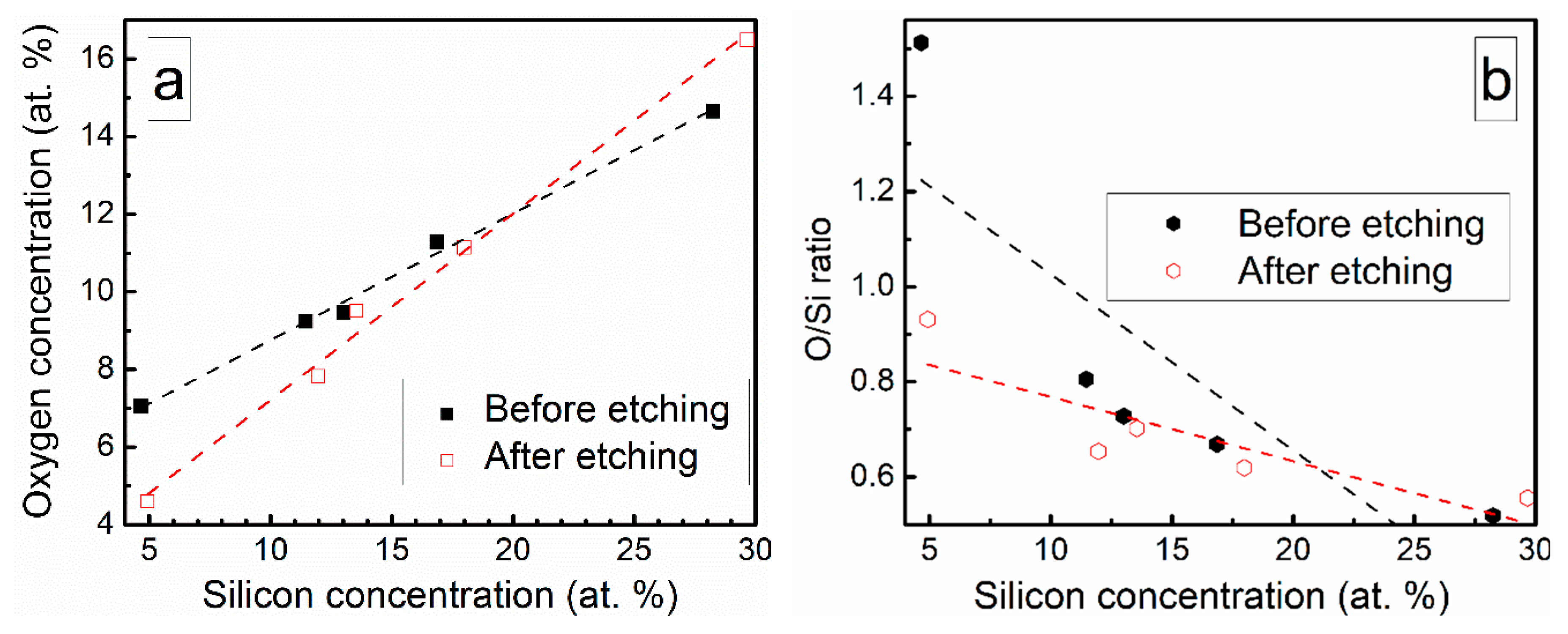
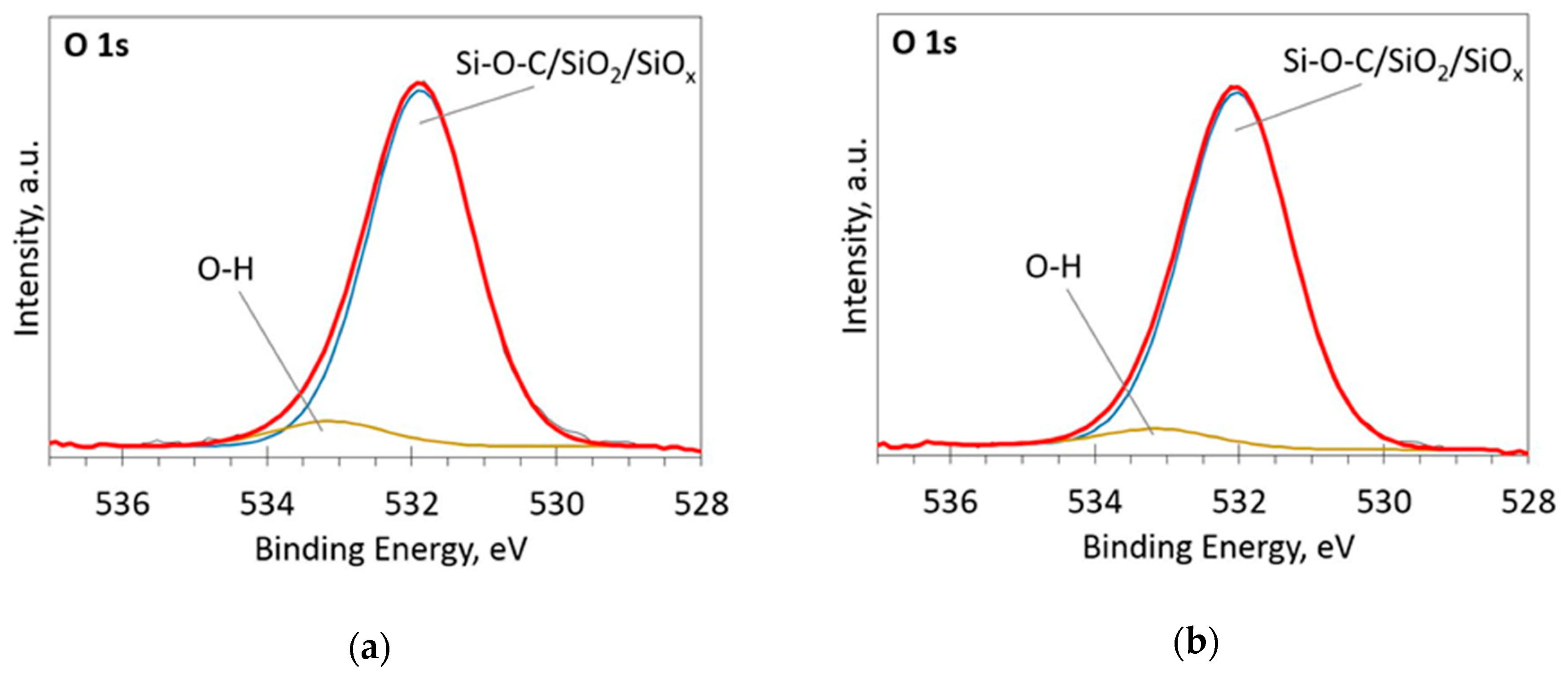
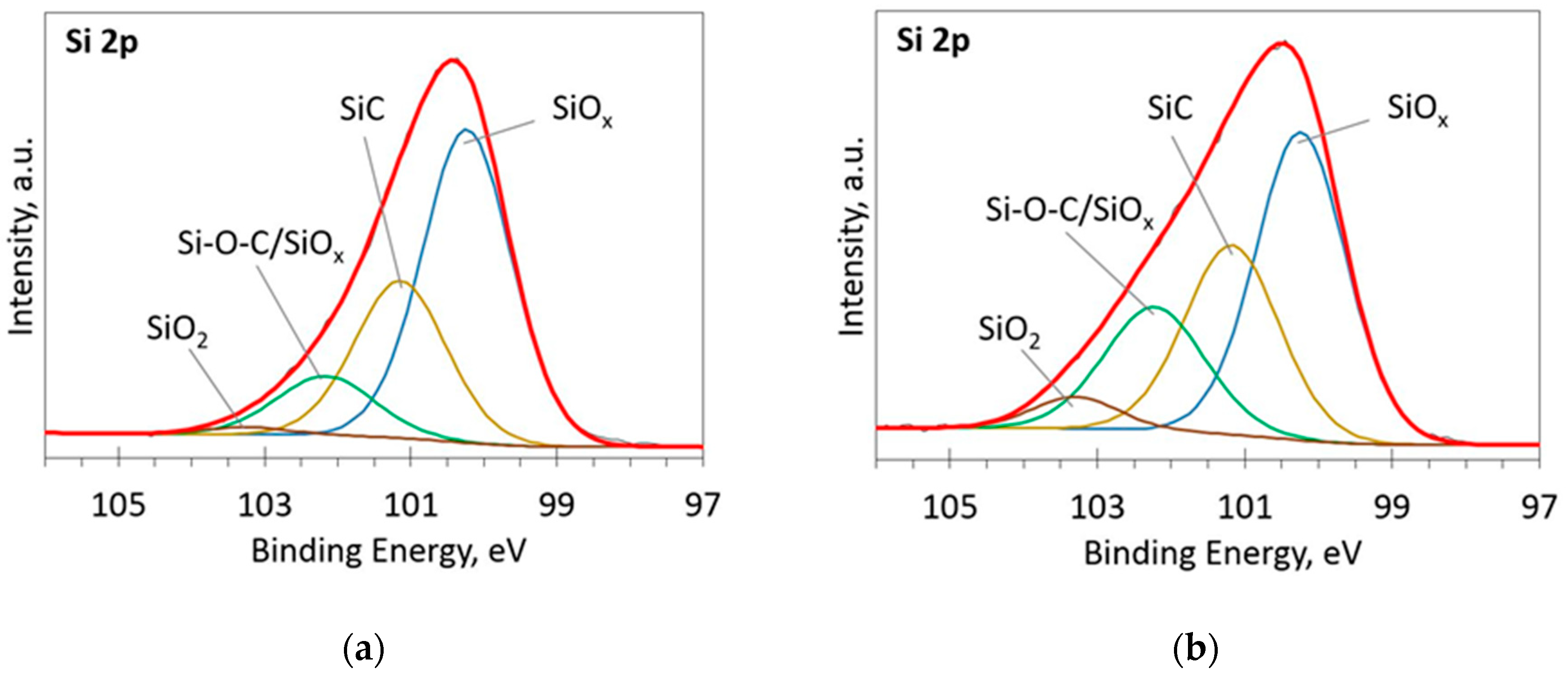
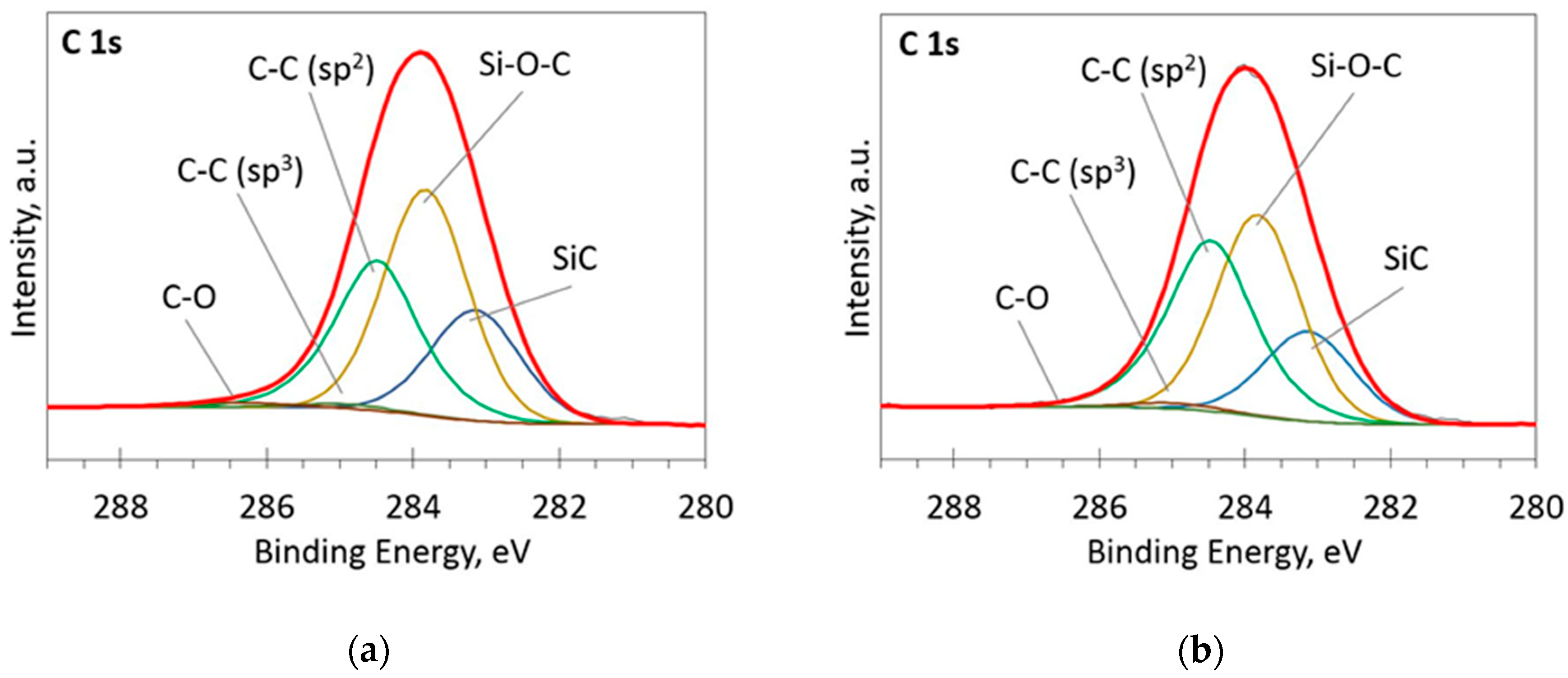
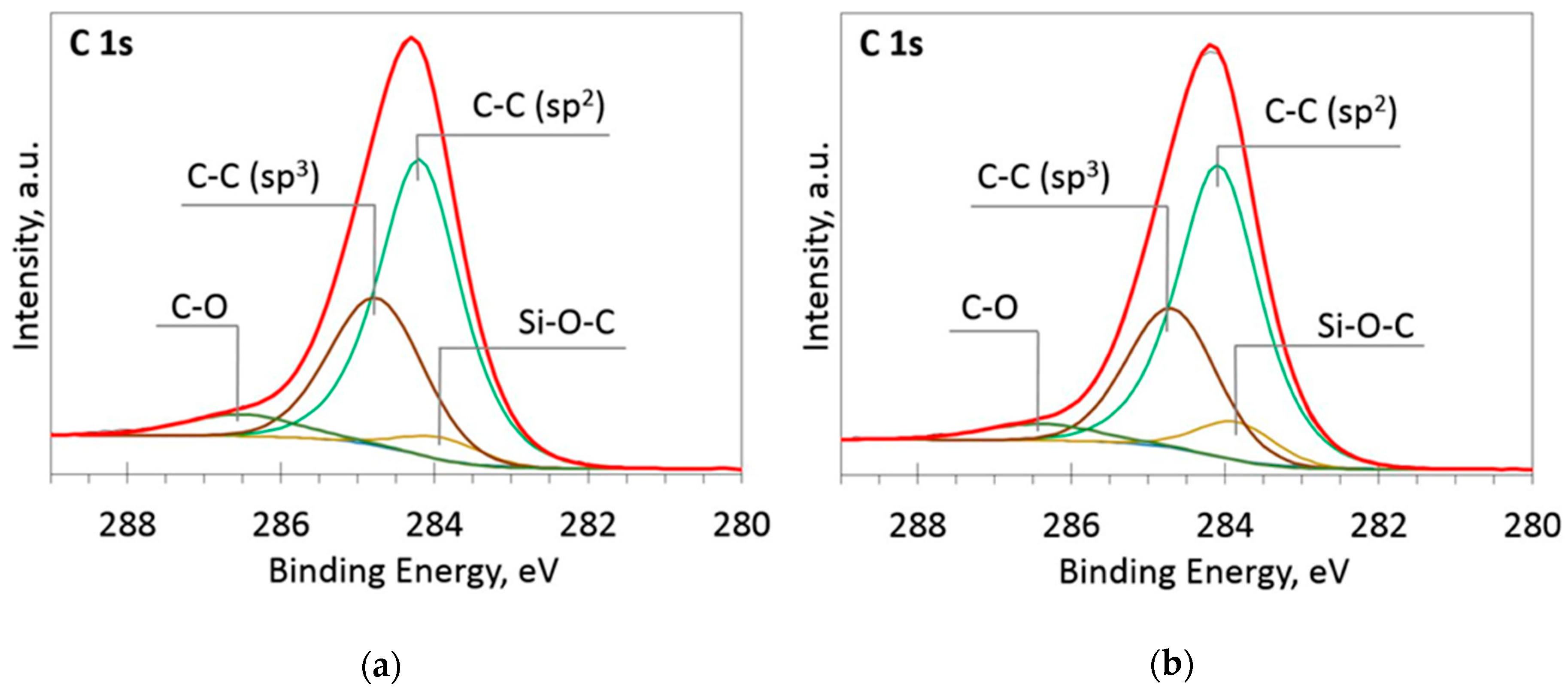
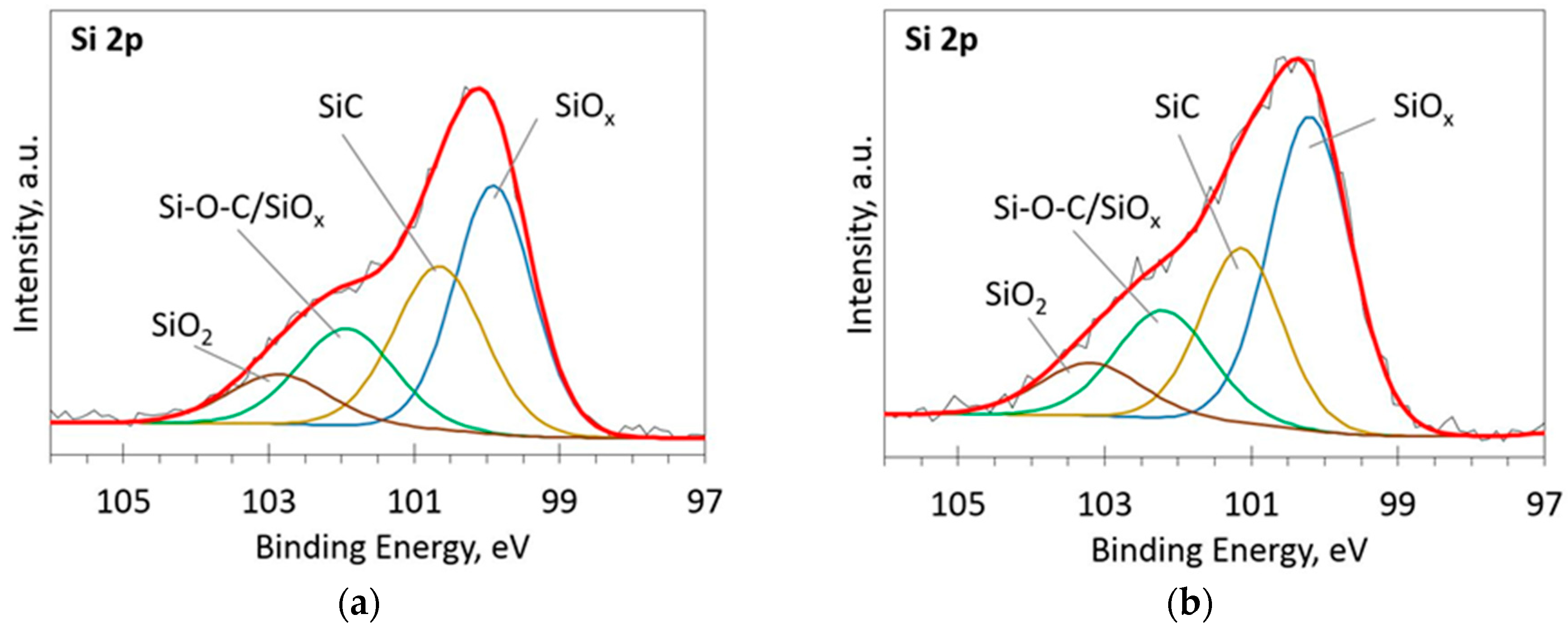

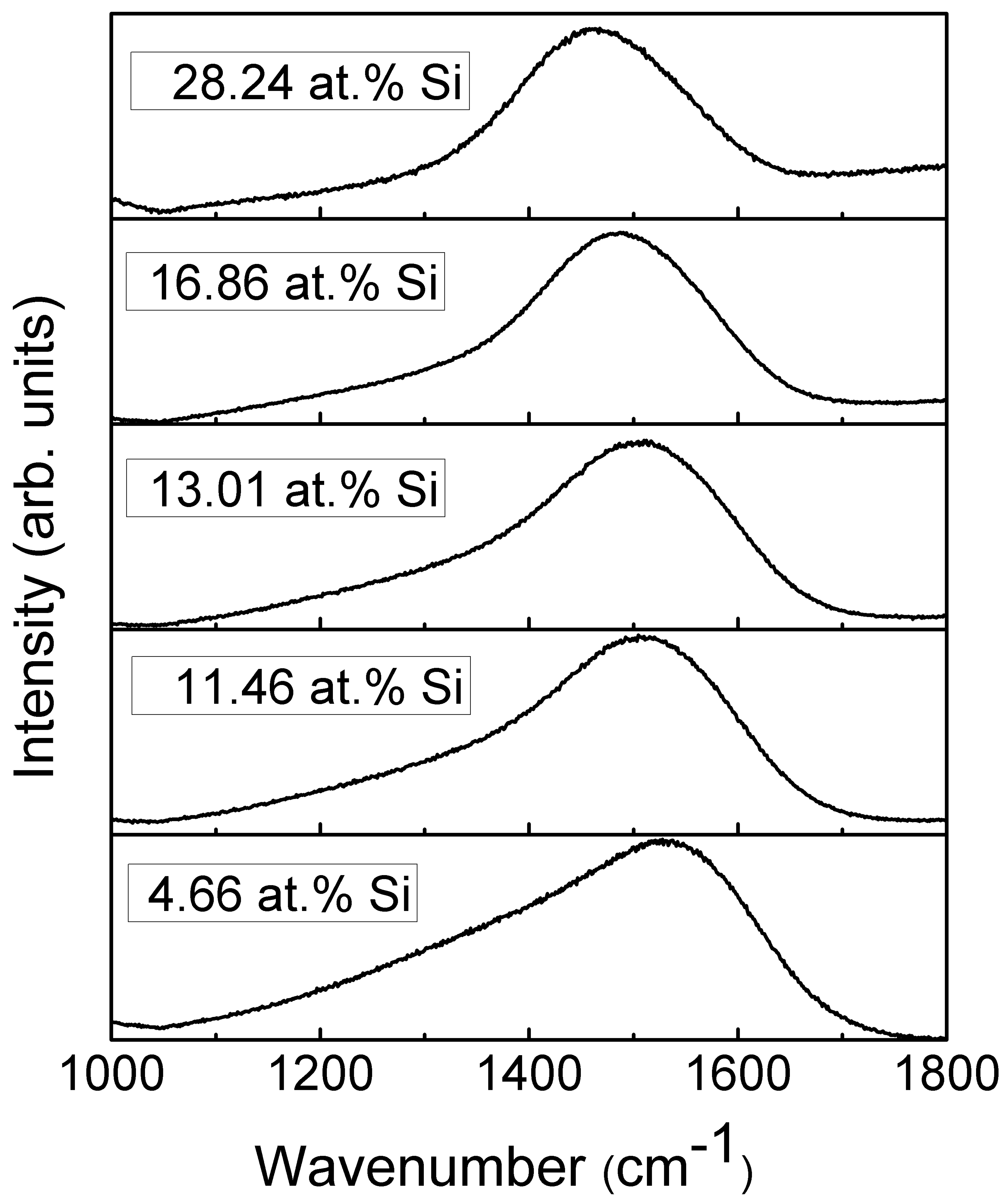

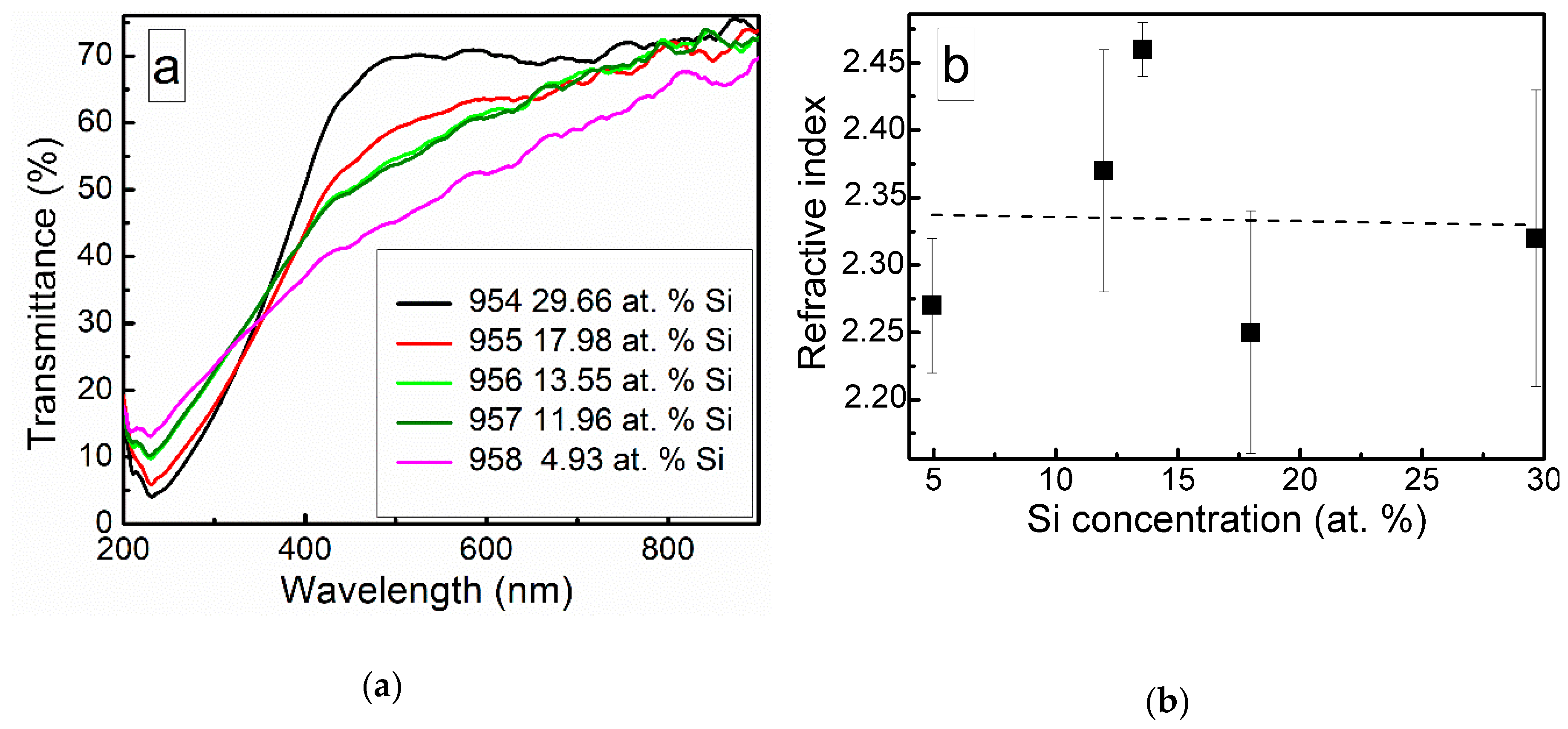
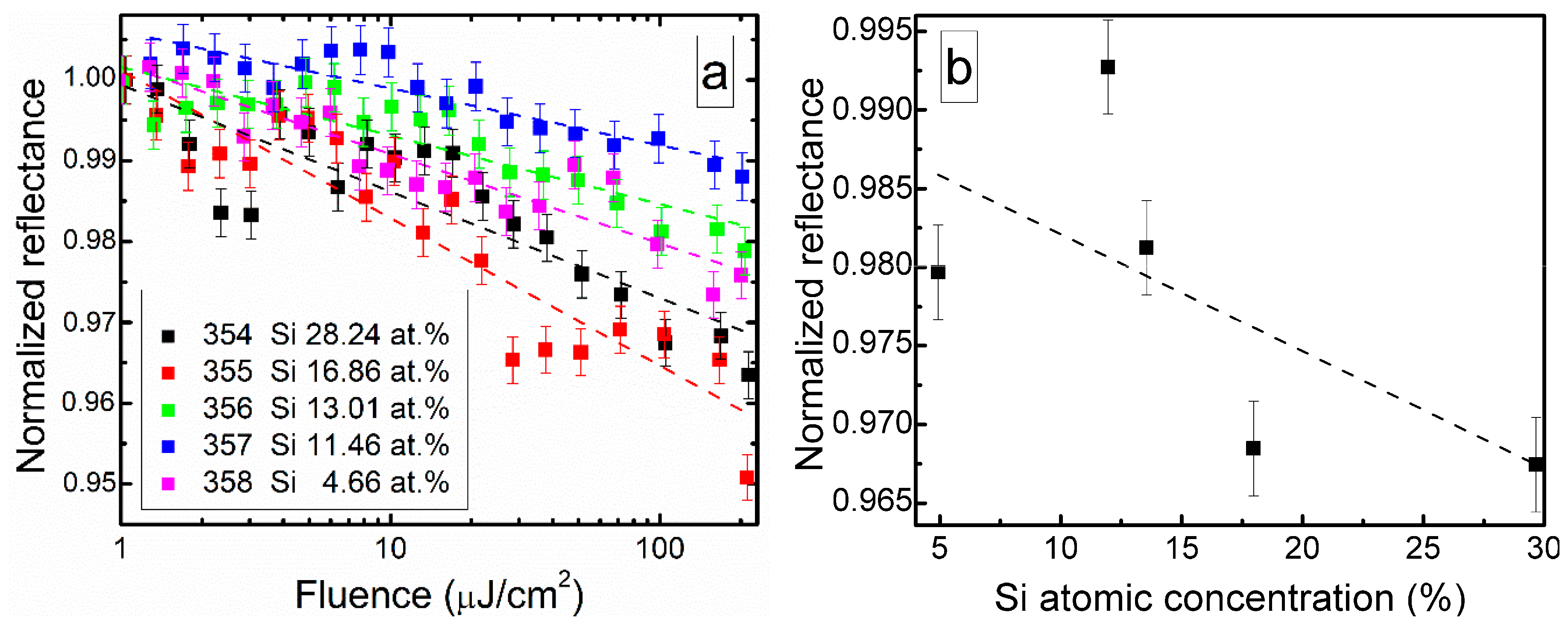
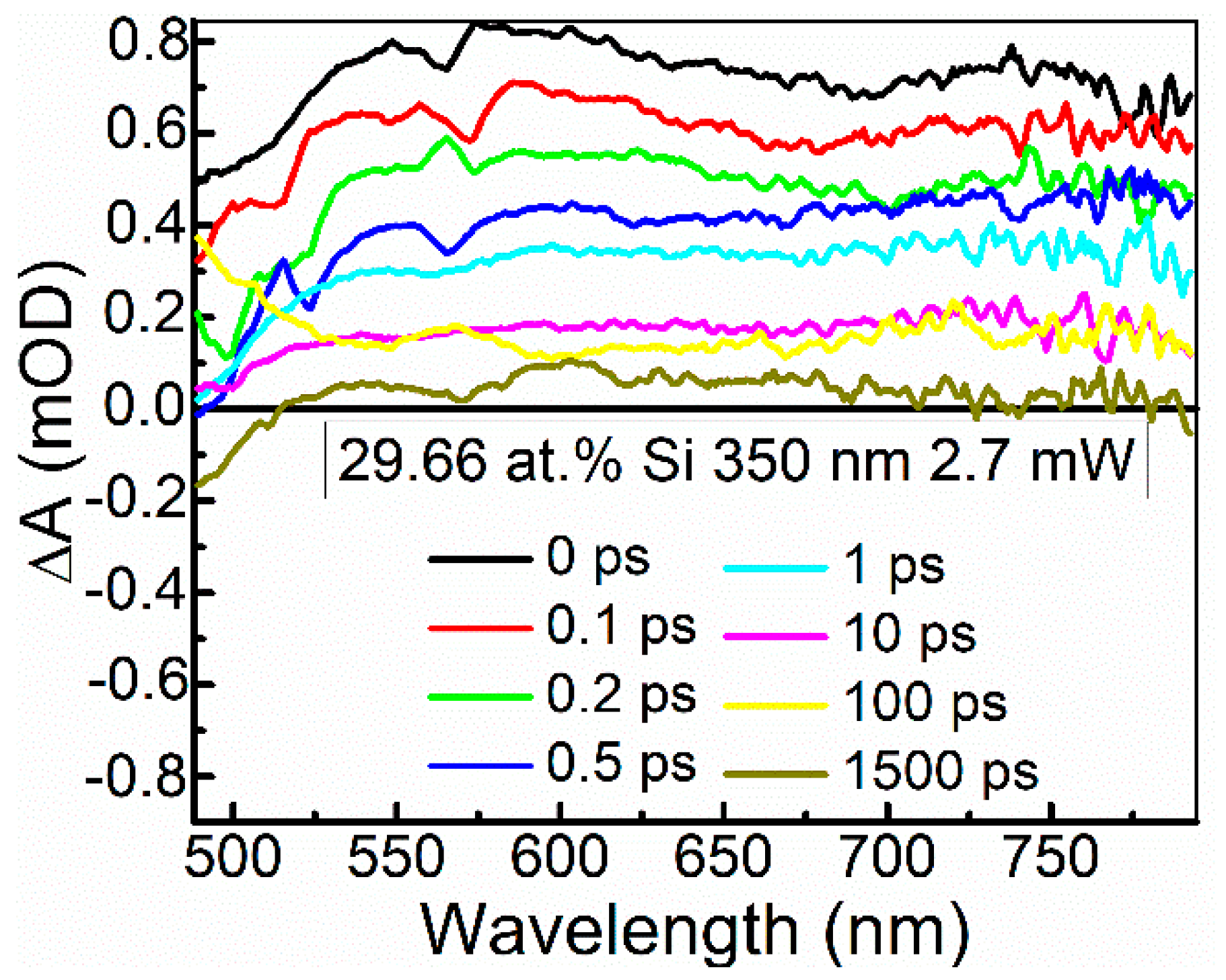

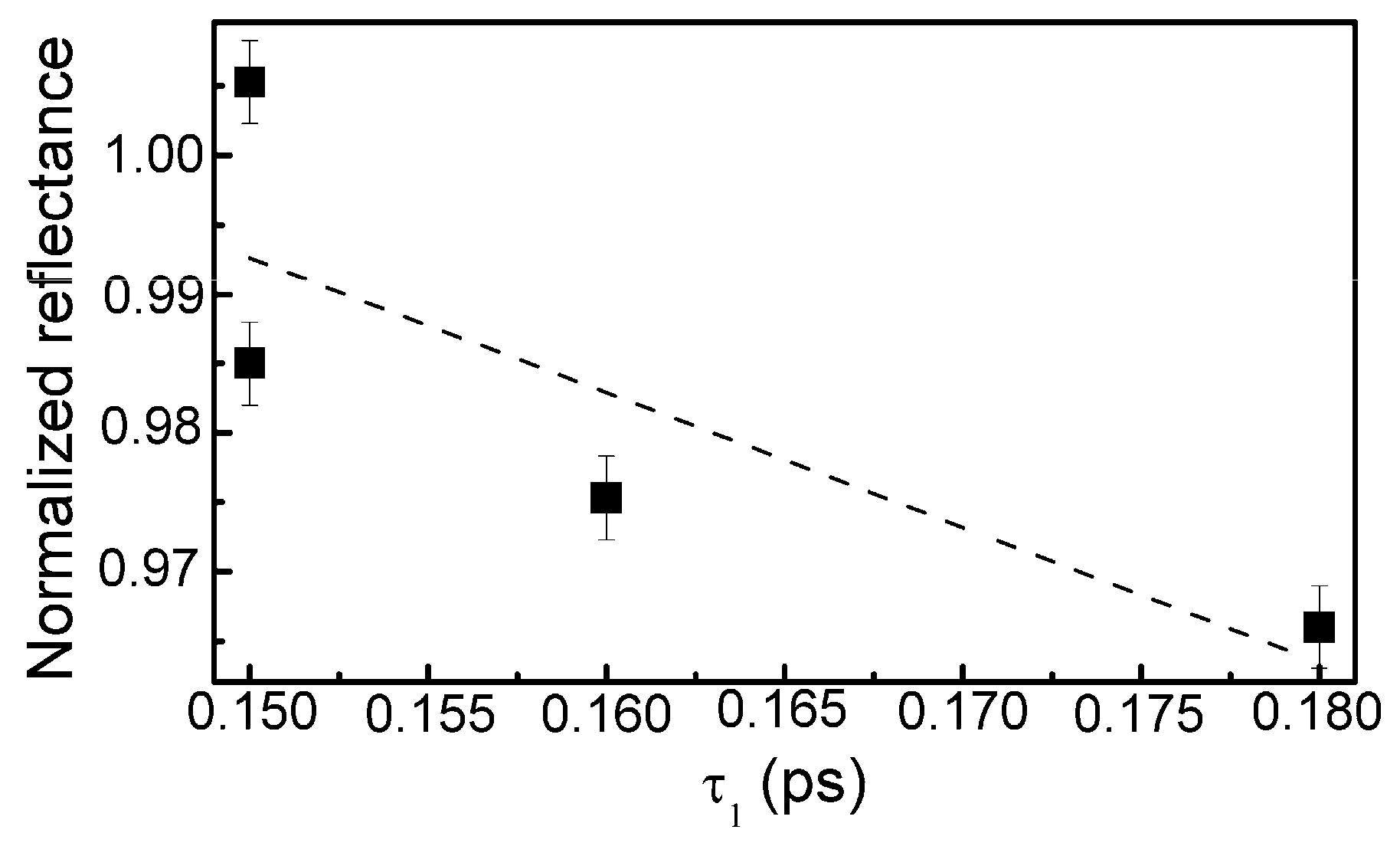
| Sample No. | Ar Gas Flow (sccm) | Target Current (A) | HMDS Liquid Flow (mg/min) | Vaporizer Temp (°C) | Comments |
|---|---|---|---|---|---|
| 954 | 140 | 0.62 | 2.5 | 40 | In all experiments, HMDS liquid flow was the lowest available for the liquid vaporizer used. |
| 955 | 140 | 0.9 | 2.5 | 40 | |
| 956 | 140 | 1.1 | 2.5 | 40 | |
| 957 | 140 | 0.9 | 2.5 | 20 | |
| 958 | 70 + 60 | 0.92 | 2.5 | 40 | Ar gas flow was split into two equal fluxes. The first one was directed to the magnetron. The second one was used as a HMDS transport gas. Afterwards, Ar and HMDS mixture was introduced in the vacuum hamber through another inlet to increase the distance between the HMDS vapor inlet and sample. |
| Sample No | Before Etching | After Etching | ||||||
|---|---|---|---|---|---|---|---|---|
| O (at.%) | C (at.%) | Si (at.%) | C/Si Ratio | O (at.%) | C (at.%) | Si (at.%) | C/Si Ratio | |
| 954 | 14.7 | 57.1 | 28.2 | 2.02 | 16.5 | 53.8 | 29.7 | 0.56 |
| 955 | 11.3 | 71.9 | 16.9 | 4.26 | 11.1 | 70.9 | 18.0 | 0.62 |
| 956 | 9.5 | 77.5 | 13.0 | 5.96 | 9.5 | 76.9 | 13.6 | 0.70 |
| 957 | 9.2 | 79.3 | 11.5 | 6.92 | 7.8 | 80.2 | 12.0 | 0.65 |
| 958 | 7.1 | 88.3 | 4.7 | 18.95 | 4.6 | 90.5 | 4.9 | 0.93 |
| Sample (Excitation) | τ1 (ps) | A1 | τ2 (ps) | A2 | τ3 (ps) | A3 | R2 |
|---|---|---|---|---|---|---|---|
| 954 (350 nm) | 0.18 ± 0.01 | 0.51 ± 0.01 | 1.97 ± 0.15 | 0.32 ± 0.01 | 65.7 ± 8.3 | 0.12 ± 0.01 | 0.997 |
| 955 (350 nm) | 0.16 ± 0.01 | 0.46 ± 0.01 | 2.00 ± 0.18 | 0.29 ± 0.01 | 96.6 ± 13.3 | 0.13 ± 0.01 | 0.996 |
| 956 (350 nm) | 0.15 ± 0.01 | 0.55 ± 0.02 | 3.19 ± 0.44 | 0.22 ± 0.01 | 137.8 ± 24.7 | 0.13 ± 0.01 | 1.000 |
| 957 (350 nm) | 0.15 ± 0.01 | 0.48 ± 0.01 | 2.56 ± 0.38 | 0.21 ± 0.01 | 105.8 ± 16.8 | 0.15 ± 0.01 | 1.000 |
© 2020 by the authors. Licensee MDPI, Basel, Switzerland. This article is an open access article distributed under the terms and conditions of the Creative Commons Attribution (CC BY) license (http://creativecommons.org/licenses/by/4.0/).
Share and Cite
Meškinis, Š.; Vasiliauskas, A.; Andrulevičius, M.; Peckus, D.; Tamulevičius, S.; Viskontas, K. Diamond Like Carbon Films Containing Si: Structure and Nonlinear Optical Properties. Materials 2020, 13, 1003. https://doi.org/10.3390/ma13041003
Meškinis Š, Vasiliauskas A, Andrulevičius M, Peckus D, Tamulevičius S, Viskontas K. Diamond Like Carbon Films Containing Si: Structure and Nonlinear Optical Properties. Materials. 2020; 13(4):1003. https://doi.org/10.3390/ma13041003
Chicago/Turabian StyleMeškinis, Šarūnas, Andrius Vasiliauskas, Mindaugas Andrulevičius, Domantas Peckus, Sigitas Tamulevičius, and Karolis Viskontas. 2020. "Diamond Like Carbon Films Containing Si: Structure and Nonlinear Optical Properties" Materials 13, no. 4: 1003. https://doi.org/10.3390/ma13041003
APA StyleMeškinis, Š., Vasiliauskas, A., Andrulevičius, M., Peckus, D., Tamulevičius, S., & Viskontas, K. (2020). Diamond Like Carbon Films Containing Si: Structure and Nonlinear Optical Properties. Materials, 13(4), 1003. https://doi.org/10.3390/ma13041003






